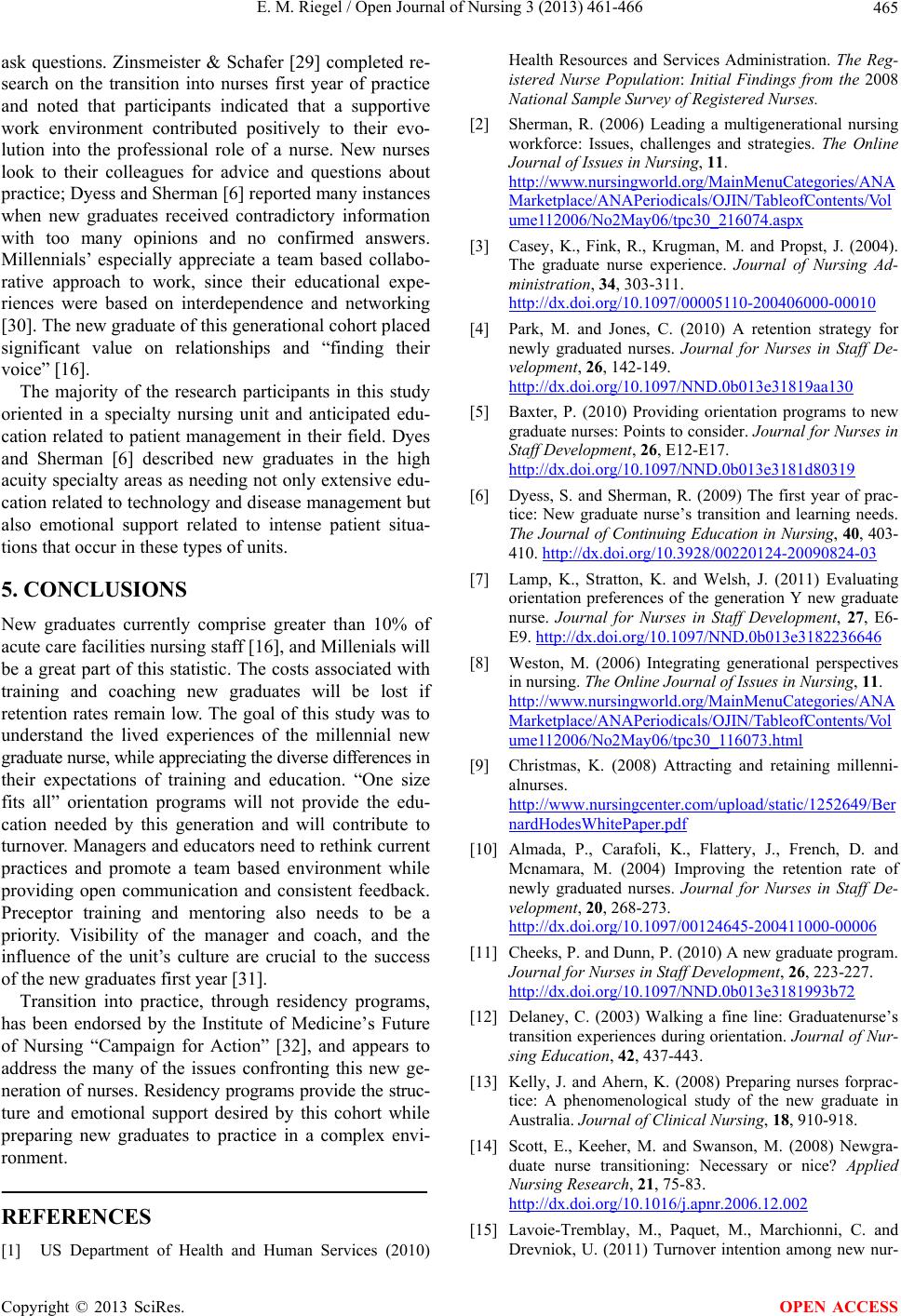
E. M. Riegel / Open Journal of Nursing 3 (2013) 461-466
Copyright © 2013 SciRes. OPEN ACCESS
465
ask questions. Zinsmeister & Schafer [29] completed re-
search on the transition into nurses first year of practice
and noted that participants indicated that a supportive
work environment contributed positively to their evo-
lution into the professional role of a nurse. New nurses
look to their colleagues for advice and questions about
practice; Dyess and Sherman [6] reported many instances
when new graduates received contradictory information
with too many opinions and no confirmed answers.
Millennials’ especially appreciate a team based collabo-
rative approach to work, since their educational expe-
riences were based on interdependence and networking
[30]. The new graduate of this generational cohort placed
significant value on relationships and “finding their
voice” [16].
The majority of the research participants in this study
oriented in a specialty nursing unit and anticipated edu-
cation related to patient management in their field. Dyes
and Sherman [6] described new graduates in the high
acuity specialty areas as needing not only extensive edu-
cation related to technology and disease management but
also emotional support related to intense patient situa-
tions that occur in these types of un its.
5. CONCLUSIONS
New graduates currently comprise greater than 10% of
acute care facilities nursing staff [16], and Millenials will
be a great part of this statistic. The costs associated with
training and coaching new graduates will be lost if
retention rates remain low. The goal of this study was to
understand the lived experiences of the millennial new
graduate nurse, while appreciating the diverse differences in
their expectations of training and education. “One size
fits all” orientation programs will not provide the edu-
cation needed by this generation and will contribute to
turnover. Managers and educators need to rethink current
practices and promote a team based environment while
providing open communication and consistent feedback.
Preceptor training and mentoring also needs to be a
priority. Visibility of the manager and coach, and the
influence of the unit’s culture are crucial to the success
of the new graduates first year [31].
Transition into practice, through residency programs,
has been endorsed by the Institute of Medicine’s Future
of Nursing “Campaign for Action” [32], and appears to
address the many of the issues confronting this new ge-
neration of nurses. Residency programs provide the struc-
ture and emotional support desired by this cohort while
preparing new graduates to practice in a complex envi-
ronment.
REFERENCES
[1] US Department of Health and Human Services (2010)
Health Resources and Services Administration. The Reg-
istered Nurse Population: Initial Findings from the 2008
National Sample Survey of Registered Nurses.
[2] Sherman, R. (2006) Leading a multigenerational nursing
workforce: Issues, challenges and strategies. The Online
Journal of Issues in Nursing, 11.
http://www.nursingworld.org/MainMenuCategories/ANA
Marketplace/ANAPeriodicals/OJIN/TableofContents/Vol
ume112006/No2May06/tpc30_216074.aspx
[3] Casey, K., Fink, R., Krugman, M. and Propst, J. (2004).
The graduate nurse experience. Journal of Nursing Ad-
ministration, 34, 303-311.
http://dx.doi.org/10.1097/00005110-200406000-00010
[4] Park, M. and Jones, C. (2010) A retention strategy for
newly graduated nurses. Journal for Nurses in Staff De-
velopment, 26, 142-149.
http://dx.doi.org/10.1097/NND.0b013e31819aa130
[5] Baxter, P. (2010) Providing orientation programs to new
graduate nurses: Points to consider. Journal for Nurses in
Staff Development, 26, E12-E17.
http://dx.doi.org/10.1097/NND.0b013e3181d80319
[6] Dyess, S. and Sherman, R. (2009) The first year of prac-
tice: New graduate nurse’s transition and learning needs.
The Journal of Continuing Educ ation in Nursing, 40, 403-
410. http://dx.doi.org/10.3928/00220124-20090824-03
[7] Lamp, K., Stratton, K. and Welsh, J. (2011) Evaluating
orientation preferences of the generation Y new graduate
nurse. Journal for Nurses in Staff Development, 27, E6-
E9. http://dx.doi.org/10.1097/NND.0b013e3182236646
[8] Weston, M. (2006) Integrating generational perspectives
in nursing. T he Online Journal o f Issu e s in Nursing, 11.
http://www.nursingworld.org/MainMenuCategories/ANA
Marketplace/ANAPeriodicals/OJIN/TableofContents/Vol
ume112006/No2May06/tpc30_116073.html
[9] Christmas, K. (2008) Attracting and retaining millenni-
alnurses.
http://www.nursingcenter.com/upload/static/1252649/Ber
nardHodesWhitePaper.pdf
[10] Almada, P., Carafoli, K., Flattery, J., French, D. and
Mcnamara, M. (2004) Improving the retention rate of
newly graduated nurses. Journal for Nurses in Staff De-
velopment, 20, 268-273.
http://dx.doi.org/10.1097/00124645-200411000-00006
[11] Cheeks, P. and Dunn, P. (2010) A new graduate program.
Journal for Nurses in Staff Development, 26, 223-227.
http://dx.doi.org/10.1097/NND.0b013e3181993b72
[12] Delaney, C. (2003) Walking a fine line: Graduatenurse’s
transition experiences during orientation. Journal of Nur-
sing Education, 42, 437-443.
[13] Kelly, J. and Ahern, K. (2008) Preparing nurses forprac-
tice: A phenomenological study of the new graduate in
Australia. Journal of Clinical Nursing, 18, 910-918.
[14] Scott, E., Keeher, M. and Swanson, M. (2008) Newgra-
duate nurse transitioning: Necessary or nice? Applied
Nursing Research, 21, 75-83.
http://dx.doi.org/10.1016/j.apnr.2006.12.002
[15] Lavoie-Tremblay, M., Paquet, M., Marchionni, C. and
Drevniok, U. (2011) Turnover intention among new nur-